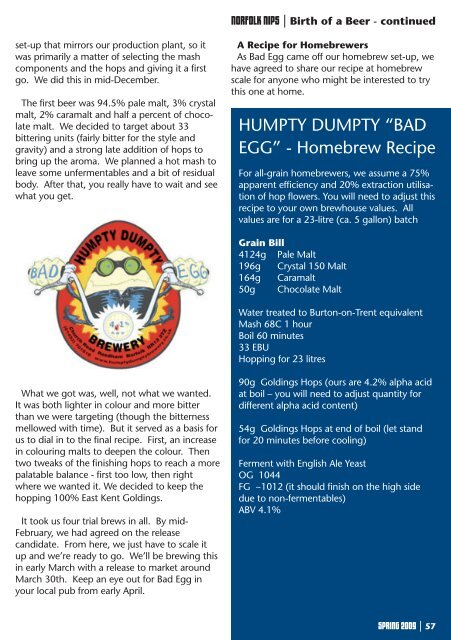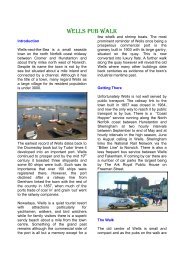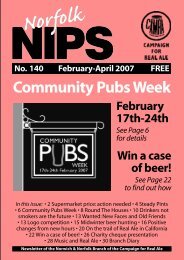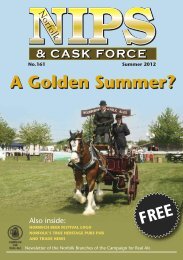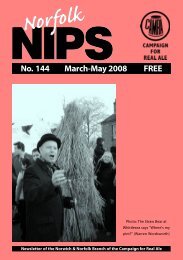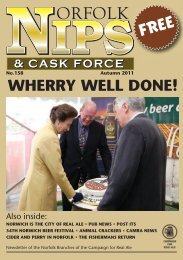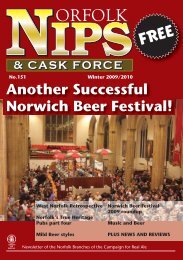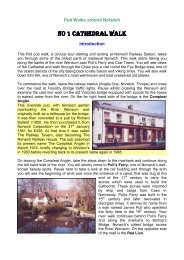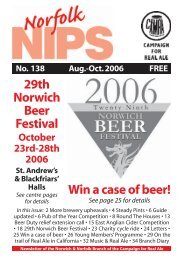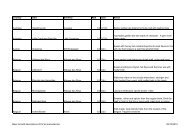Create successful ePaper yourself
Turn your PDF publications into a flip-book with our unique Google optimized e-Paper software.
NORFOLK NIPS | Birth of a Beer - continued<br />
set-up that mirrors our production plant, so it<br />
was primarily a matter of selecting the mash<br />
components <strong>and</strong> the hops <strong>and</strong> giving it a first<br />
go. We did this in mid-December.<br />
The first beer was 94.5% pale malt, 3% crystal<br />
malt, 2% caramalt <strong>and</strong> half a percent of chocolate<br />
malt. We decided to target about 33<br />
bittering units (fairly bitter for the style <strong>and</strong><br />
gravity) <strong>and</strong> a strong late addition of hops to<br />
bring up the aroma. We planned a hot mash to<br />
leave some unfermentables <strong>and</strong> a bit of residual<br />
body. After that, you really have to wait <strong>and</strong> see<br />
what you get.<br />
A Recipe for Homebrewers<br />
As Bad Egg came off our homebrew set-up, we<br />
have agreed to share our recipe at homebrew<br />
scale for anyone who might be interested to try<br />
this one at home.<br />
HUMPTY DUMPTY “BAD<br />
EGG” - Homebrew Recipe<br />
For all-grain homebrewers, we assume a 75%<br />
apparent efficiency <strong>and</strong> 20% extraction utilisation<br />
of hop flowers. You will need to adjust this<br />
recipe to your own brewhouse values. All<br />
values are for a 23-litre (ca. 5 gallon) batch<br />
Grain Bill<br />
4124g Pale Malt<br />
196g Crystal 150 Malt<br />
164g Caramalt<br />
50g Chocolate Malt<br />
Water treated to Burton-on-Trent equivalent<br />
Mash 68C 1 hour<br />
Boil 60 minutes<br />
33 EBU<br />
Hopping for 23 litres<br />
What we got was, well, not what we wanted.<br />
It was both lighter in colour <strong>and</strong> more bitter<br />
than we were targeting (though the bitterness<br />
mellowed with time). But it served as a basis for<br />
us to dial in to the final recipe. First, an increase<br />
in colouring malts to deepen the colour. Then<br />
two tweaks of the finishing hops to reach a more<br />
palatable balance - first too low, then right<br />
where we wanted it. We decided to keep the<br />
hopping 100% East Kent Goldings.<br />
It took us four trial brews in all. By mid-<br />
February, we had agreed on the release<br />
c<strong>and</strong>idate. From here, we just have to scale it<br />
up <strong>and</strong> we’re ready to go. We’ll be brewing this<br />
in early March with a release to market around<br />
March 30th. Keep an eye out for Bad Egg in<br />
your local pub from early April.<br />
90g Goldings Hops (ours are 4.2% alpha acid<br />
at boil – you will need to adjust quantity for<br />
different alpha acid content)<br />
54g Goldings Hops at end of boil (let st<strong>and</strong><br />
for 20 minutes before cooling)<br />
Ferment with English Ale Yeast<br />
OG 1044<br />
FG ~1012 (it should finish on the high side<br />
due to non-fermentables)<br />
ABV 4.1%<br />
SPRING 2009 | 57


